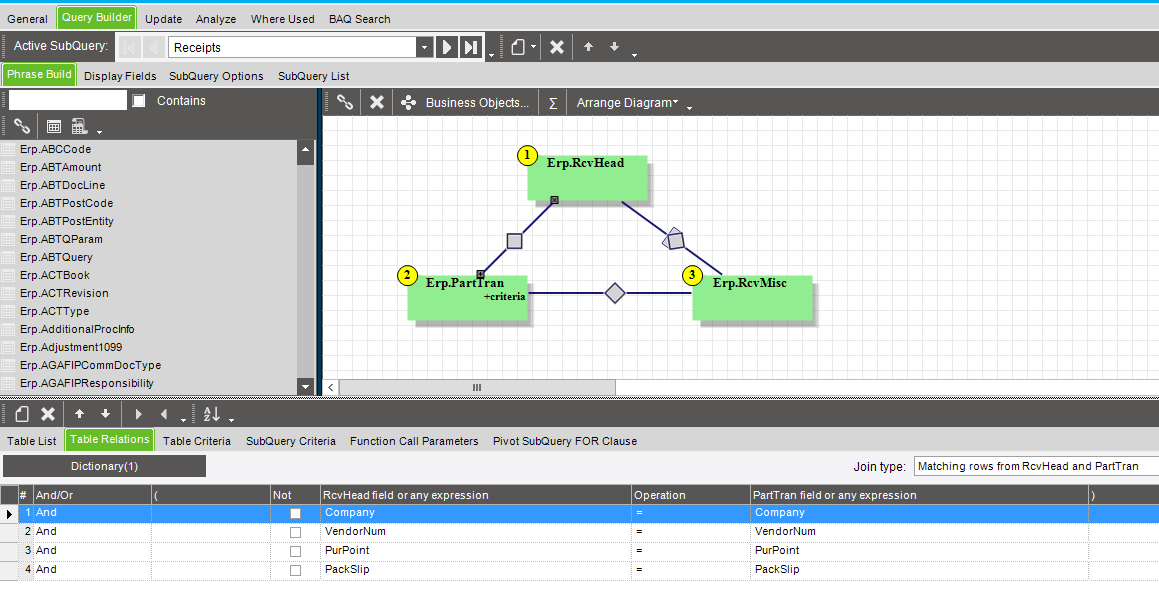Here is the SQL for the full baq. There are two CTE’s and one TopLevel.
with [Receipts] as
(select
[PartTran].[PONum] as [PartTran_PONum],
[PartTran].[POLine] as [PartTran_POLine],
[PartTran].[PackSlip] as [PartTran_PackSlip],
[RcvHead].[PackSlip] as [RcvHead_PackSlip],
[PartTran].[PackLine] as [PartTran_PackLine],
[PartTran].[PartNum] as [PartTran_PartNum],
[RcvHead].[LandedCost] as [RcvHead_LandedCost],
[RcvMisc].[DocActualAmt] as [RcvMisc_DocActualAmt],
(PartTran.MtlBurUnitCost * PartTran.TranQty) as [Calculated_EstFreight],
[PartTran].[PostedToGL] as [PartTran_PostedToGL],
[RcvMisc].[InvoiceNum] as [RcvMisc_InvoiceNum],
[RcvHead].[ReceiptDate] as [RcvHead_ReceiptDate],
[RcvHead].[VendorNum] as [RcvHead_VendorNum],
[RcvMisc].[ActualAmt] as [RcvMisc_ActualAmt],
[RcvMisc].[InvoiceLine] as [RcvMisc_InvoiceLine],
[RcvMisc].[ApplyDate] as [RcvMisc_ApplyDate],
[RcvHead].[EntryDate] as [RcvHead_EntryDate],
[PartTran].[TranQty] as [PartTran_TranQty]
from Erp.RcvHead as RcvHead
inner join Erp.PartTran as PartTran on
RcvHead.Company = PartTran.Company
and RcvHead.VendorNum = PartTran.VendorNum
and RcvHead.PurPoint = PartTran.PurPoint
and RcvHead.PackSlip = PartTran.PackSlip
and ( (PartTran.TranType = ‘PUR-STK’ or PartTran.TranType = ‘PUR-INS’ ) )
left outer join Erp.RcvMisc as RcvMisc on
RcvHead.Company = RcvMisc.Company
and RcvHead.VendorNum = RcvMisc.VendorNum
and RcvHead.PurPoint = RcvMisc.PurPoint
and RcvHead.PackSlip = RcvMisc.PackSlip
inner join Erp.RcvMisc as RcvMisc
and
PartTran.Company = RcvMisc.Company
and PartTran.VendorNum = RcvMisc.VendorNum
and PartTran.PackSlip = RcvMisc.PackSlip
and PartTran.PackLine = RcvMisc.PackLine)
,[Invoices] as
(select
[GLJrnDtl].[Description] as [GLJrnDtl_Description],
[APInvHed].[InvoiceDate] as [APInvHed_InvoiceDate],
[APInvHed].[ApplyDate] as [APInvHed_ApplyDate],
[APInvHed].[Description] as [APInvHed_Description],
[APInvHed].[InvoiceNum] as [APInvHed_InvoiceNum],
[APInvHed].[VendorNum] as [APInvHed_VendorNum],
[GLJrnDtl].[BookDebitAmount] as [GLJrnDtl_BookDebitAmount],
[GLJrnDtl].[BookCreditAmount] as [GLJrnDtl_BookCreditAmount]
from Erp.GLJrnDtl as GLJrnDtl
inner join Erp.APInvHed as APInvHed on
GLJrnDtl.Company = APInvHed.Company
and GLJrnDtl.APInvoiceNum = APInvHed.InvoiceNum
and GLJrnDtl.VendorNum = APInvHed.VendorNum
inner join Erp.APInvMsc as APInvMsc on
GLJrnDtl.Company = APInvMsc.Company
and GLJrnDtl.VendorNum = APInvMsc.VendorNum
and GLJrnDtl.BookDebitAmount = APInvMsc.MiscAmt
inner join Erp.APInvMsc as APInvMsc
and
APInvHed.Company = APInvMsc.Company
and APInvHed.VendorNum = APInvMsc.VendorNum
and APInvHed.InvoiceNum = APInvMsc.InvoiceNum
where (GLJrnDtl.BalanceAcct = ‘21030|000|300’))
select
[Receipts].[PartTran_PONum] as [PartTran_PONum],
[Receipts].[PartTran_POLine] as [PartTran_POLine],
[Receipts].[PartTran_PackSlip] as [PartTran_PackSlip],
[Receipts].[PartTran_PackLine] as [PartTran_PackLine],
[Receipts].[PartTran_PartNum] as [PartTran_PartNum],
[Receipts].[RcvHead_LandedCost] as [RcvHead_LandedCost],
[Receipts].[PartTran_TranQty] as [PartTran_TranQty],
[Receipts].[RcvHead_EntryDate] as [RcvHead_EntryDate],
[Receipts].[RcvMisc_DocActualAmt] as [RcvMisc_DocActualAmt],
[Receipts].[Calculated_EstFreight] as [Calculated_EstFreight],
[Receipts].[PartTran_PostedToGL] as [PartTran_PostedToGL],
[Receipts].[RcvMisc_InvoiceNum] as [RcvMisc_InvoiceNum],
[Invoices].[GLJrnDtl_Description] as [GLJrnDtl_Description],
[Invoices].[APInvHed_InvoiceDate] as [APInvHed_InvoiceDate],
[Invoices].[APInvHed_Description] as [APInvHed_Description],
[Invoices].[APInvHed_InvoiceNum] as [APInvHed_InvoiceNum]
from Receipts as Receipts
left outer join Invoices as Invoices on
Receipts.RcvMisc_ActualAmt = Invoices.GLJrnDtl_BookDebitAmount
and Receipts.RcvMisc_InvoiceNum = Invoices.APInvHed_InvoiceNum
and Receipts.RcvMisc_ActualAmt = Invoices.GLJrnDtl_BookDebitAmount
